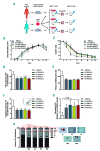Bone marrow mesenchymal stem/stromal cells from risk-stratified acute myeloid leukemia patients are anti-inflammatory in in vivo preclinical models of hematopoietic reconstitution and severe colitis
- PMID: 30237260
- PMCID: PMC6355484
- DOI: 10.3324/haematol.2018.196568
Bone marrow mesenchymal stem/stromal cells from risk-stratified acute myeloid leukemia patients are anti-inflammatory in in vivo preclinical models of hematopoietic reconstitution and severe colitis
Figures



Similar articles
-
The use of unlicensed bone marrow-derived platelet lysate-expanded mesenchymal stromal cells in colitis: a pre-clinical study.Cytotherapy. 2019 Feb;21(2):175-188. doi: 10.1016/j.jcyt.2018.11.011. Epub 2019 Jan 2. Cytotherapy. 2019. PMID: 30611671
-
Mesenchymal Stromal Cells in Pediatric Hematopoietic Cell Transplantation a Review and a Pilot Study in Children Treated With Decidua Stromal Cells for Acute Graft-versus-Host Disease.Front Immunol. 2020 Oct 19;11:567210. doi: 10.3389/fimmu.2020.567210. eCollection 2020. Front Immunol. 2020. PMID: 33193339 Free PMC article.
-
Bone marrow stromal cell therapy improves survival after radiation injury but does not restore endogenous hematopoiesis.Sci Rep. 2020 Dec 17;10(1):22211. doi: 10.1038/s41598-020-79278-y. Sci Rep. 2020. PMID: 33335275 Free PMC article.
-
Significance of Cellular Cross-Talk in Stromal Vascular Fraction of Adipose Tissue in Neovascularization.Arterioscler Thromb Vasc Biol. 2019 Jun;39(6):1034-1044. doi: 10.1161/ATVBAHA.119.312425. Arterioscler Thromb Vasc Biol. 2019. PMID: 31018663 Free PMC article. Review.
-
MSC-Derived Extracellular Vesicles: New Emergency Treatment to Limit the Development of Radiation-Induced Hematopoietic Syndrome?Health Phys. 2020 Jul;119(1):21-36. doi: 10.1097/HP.0000000000001264. Health Phys. 2020. PMID: 32384375 Review.
Cited by
-
Robust In Vitro and In Vivo Immunosuppressive and Anti-inflammatory Properties of Inducible Caspase-9-mediated Apoptotic Mesenchymal Stromal/Stem Cell.Stem Cells Transl Med. 2022 Mar 3;11(1):88-96. doi: 10.1093/stcltm/szab007. Stem Cells Transl Med. 2022. PMID: 35641173 Free PMC article.
-
Engraftment characterization of risk-stratified AML in NSGS mice.Blood Adv. 2021 Dec 14;5(23):4842-4854. doi: 10.1182/bloodadvances.2020003958. Blood Adv. 2021. PMID: 34470043 Free PMC article.
-
High-efficient generation of VCAM-1+ mesenchymal stem cells with multidimensional superiorities in signatures and efficacy on aplastic anaemia mice.Cell Prolif. 2020 Aug;53(8):e12862. doi: 10.1111/cpr.12862. Epub 2020 Jun 29. Cell Prolif. 2020. PMID: 32597552 Free PMC article.
-
The Multi-Kinase Inhibitor EC-70124 Is a Promising Candidate for the Treatment of FLT3-ITD-Positive Acute Myeloid Leukemia.Cancers (Basel). 2022 Mar 21;14(6):1593. doi: 10.3390/cancers14061593. Cancers (Basel). 2022. PMID: 35326743 Free PMC article.
-
Effects of Resveratrol, Curcumin and Quercetin Supplementation on Bone Metabolism-A Systematic Review.Nutrients. 2022 Aug 26;14(17):3519. doi: 10.3390/nu14173519. Nutrients. 2022. PMID: 36079777 Free PMC article.
References
-
- Grimwade D, Lo Coco F. Acute promyelocytic leukemia: a model for the role of molecular diagnosis and residual disease monitoring in directing treatment approach in acute myeloid leukemia. Leukemia. 2002;16(10):1959–1973. - PubMed
Publication types
MeSH terms
Grants and funding
LinkOut - more resources
Full Text Sources
Other Literature Sources

